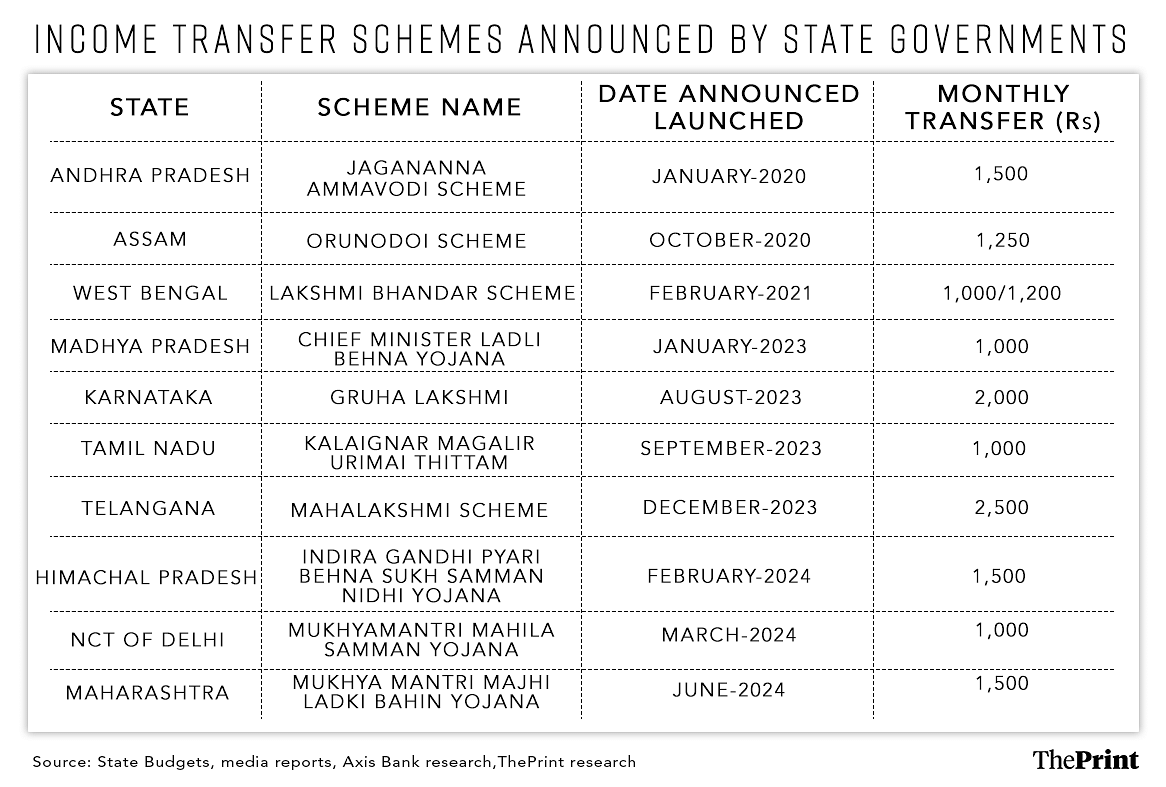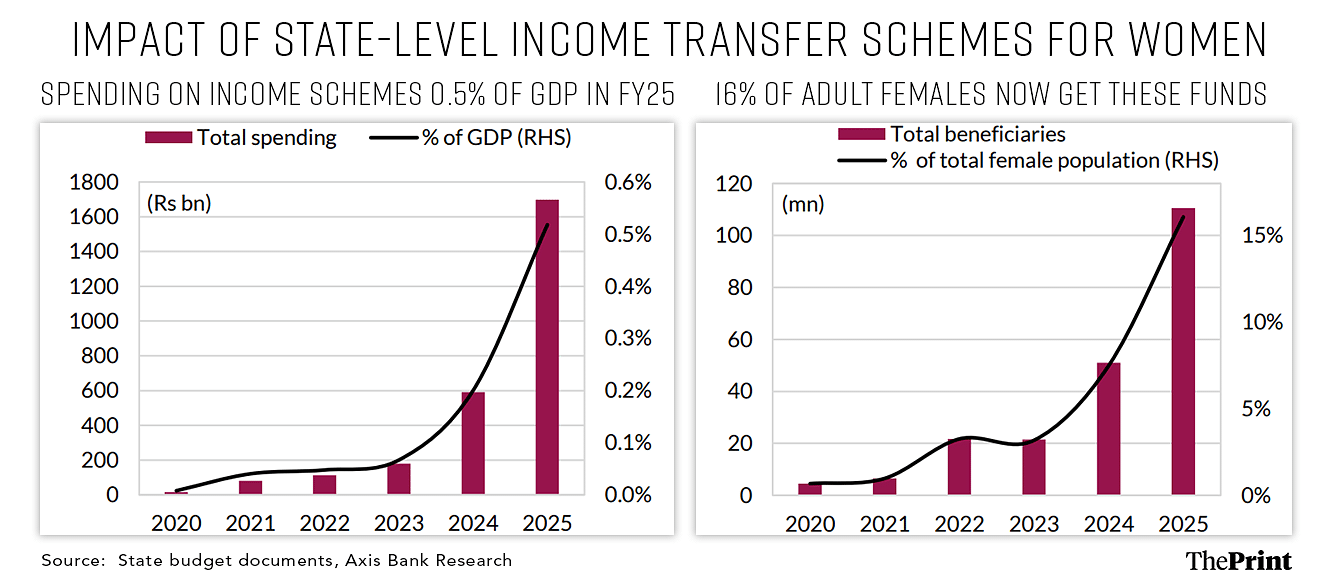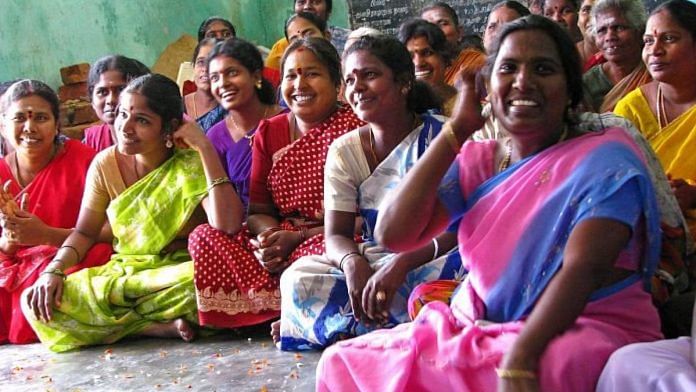New Delhi: The post-pandemic period has seen India’s women increasingly being targeted by state governments for welfare measures, and, in particular, income transfer schemes, with 16 percent of India’s women now receiving some form of income support, an analysis has found.
An analysis of state budgets and schemes by Axis Bank’s economic research team has found that 10 states now provide income support to women, with Maharashtra being the latest to join this list.
Income transfers to women now total Rs 1.8 lakh crore a year, which works out to 0.8 percent of these states’ combined gross state domestic product (GSDP), and 0.6 percent of India’s gross domestic product.
A separate report by State Bank of India’s (SBI) research desk says that these schemes for women are part of a larger trend where several large states are now devoting significant portions of their revenue receipts to welfare schemes.
“Two weeks back, the Maharashtra state government presented a supplementary budget for FY25,” the Axis Bank report said. “New schemes included a new income-transfer scheme: Chief Minister’s Ladki Bahin Scheme, which allocates Rs 46,000 crore (0.8 percent of the GSDP) for transferring Rs 1,500/month to 26 million (2.6 crore) women. Maharashtra is the 10th state to announce such a scheme.”
The schemes in these 10 states now cover 11 crore women, the data showed.

There has been a marked acceleration in the frequency of women-focussed income transfer schemes being announced, with the last two years each seeing more such announcements than in the 2020-22 period.
Maharashtra’s announcement of its scheme came soon after the Delhi government announced its Mukhyamantri Mahila Samman Yojana in March 2024, under which the state government said it would transfer Rs 1,000 a month to eligible women.
Himachal Pradesh in February 2024 announced its Indira Gandhi Pyari Behna Sukh Samman Nidhi Yojana, under which it said it would transfer Rs 1,500 per month to all women in the state above the age of 18.
Prior to that, 2023 saw four other state governments announcing such schemes — Madhya Pradesh (Rs 1,000 per month), Karnataka (Rs 2,000 per month), Tamil Nadu (Rs 1,000 per month) and Telangana (Rs 2,500 per month).
“While states like West Bengal, Madhya Pradesh and Maharashtra launched these schemes ahead of state polls, Telangana and Karnataka started after a new government came to power in the state,” the Axis report noted.
“Nationally, FY25 spend would reach 0.5 percent of GDP in FY25, vs 0.2 percent in FY24, but for states running these schemes, these amount to 0.8-19 percent of total expenditure and 0.2-3.2 percent of GSDP,” it added.

Also read: Why is Modi govt afraid of its own successes? Banking, stock market, GST hold the answer
Moving to a welfare state
The SBI report noted that India seems to be transitioning to a ‘welfare state’ with many states opting for more welfare-oriented schemes for its citizens.
It further noted that many large states, including Maharashtra, Andhra Pradesh, Karnataka and Kerala, are now spending or proposing to spend significant portions of their revenue receipts on welfare schemes.
Maharashtra, for example, proposes to spend 11 percent of its budgeted revenue receipts for FY25 on welfare schemes, with the largest of these schemes being the one for women. Andhra Pradesh, too, expects to spend 11 percent of its FY25 revenue receipts on welfare schemes.
Karnataka, however, is estimated to spend as much as 15 percent of its FY25 revenue receipts on welfare schemes, and here, too, the bulk of this spending is for the income transfer scheme for women. Kerala, Odisha, and West Bengal have projected they will spend between 8-10 percent of their revenue receipts on welfare.
“It may be mentioned that some schemes which are designed for welfare of health and education of women and children, girl child are essential for women empowerment, economic growth and development of the country, but these must be properly targeted,” SBI said.
Axis Bank further said that, going forward, it was highly likely that the state governments would take the lead on income-transfer schemes, since the Centre has to contend with high debt levels and the inflationary impact of a national-level scheme.
Won’t harm state finances
Despite the large portion of revenue receipts being allocated for such schemes, this won’t harm the fiscal health of these states since their expenditure patterns show they are substituting expenditure from other schemes to pay for the women-oriented ones.
“Budgeted FY25 deficits for these states are currently above FY23 actuals, but… actual deficits are generally below budgeted numbers,” the Axis report said. “(With) state borrowing being capped at 3 percent of GSDP, these spends substitute other expenditures, limiting overall fiscal impact.”
The report added that, as long as states don’t cut their capital expenditure, this re-routing of revenue expenditure to such income transfer schemes — which have lower administrative costs — makes the state-level welfare spending more efficient.
Also read: 54 lakh informal jobs lost, stagnant worker output — how DeMo, GST & COVID hit India’s manufacturing






